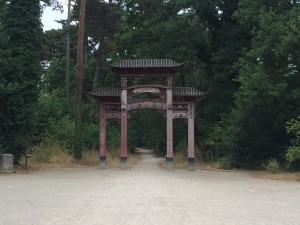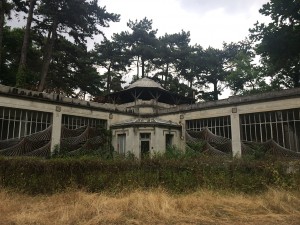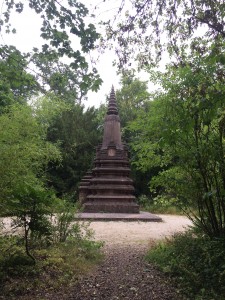The history of a city desires to be discovered, excavated, uncovered. The flâneur travels by imaginary roads, streets that no longer exist, or are now merely remnants, reconfigured, redrawn, remodeled fragments. To begin redrawing history is to reimagine its beginnings, or to question its beginning. Not exactly how a place comes to be, but when.
Decolonization, I realized, requires the imaginary to take precedent over the present. I had to break every space into pieces: Porte de Choisy of the 13th arrondissement of the city of Paris of the country of France. And so the narrative stretches further…

During my third week of research, I took the RER B (Réseau Express Régional, or the commuter rail) to Nogent-sur-Marne, a commune in Paris’s eastern suburbs to see the Garden of Tropical Agronomy. Located in the corner of the Bois de Vincennes, the garden is a public park owned and operated by the city of Paris. However in the past, the garden was the original site of the Paris Colonial Exposition held in 1907 (the history behind the exposition was further touched on in the introductory exhibit at the Museum of Immigration!). Prior to the exposition, the garden was a research laboratory dedicated to studying indigenous flora and fauna from the colonies. The impetus behind the exposition was to showcase the early 20th century French Empire’s overseas possessions. A few notable colonies representing different pockets of the world were presented at the exposition; huts were constructed in their respective cultural “style.” Tunisia, Madagascar, the Congo, and Indochina were among the select colonies chosen.

Furthermore, many colonial subjects from these places were brought to the Exposition to these “villages” where they would “live” and “interact” with the visitors, offering an account to quotidian colonial life. These villages essentially served as “human zoos.”
“Geography was essentially the material underpinning for knowledge about the Orient… Thus on the one hand the geographical Orient nourished its inhabitants, guaranteed their characteristics, and defined their specificity; on the other hand, the geographical Orient solicited the West’s attention” (216, Said).
As Edward Said noted in Orientalism, knowing the Orient (or any colonized, fabricated space) was the defining methodology of the colonizing Empire; sustaining the human zoos was a way to legitimize the Empire’s knowledge of these colonized subjects. Through the daily maintenance of the Exposition, the history of these colonies was constantly in the state of epistemic reterritorialization and conquest.

After the exposition passed, the site served as a hospital for wounded French soldiers during WWI. As a result of the many passing bodies, whether contested to be truly “French” or “native,” a series of monuments were erected to commemorate those Indo/Afro-French subjects who fought on behalf of the Empire. Walking through the garden was like wading through layers of memory, a site embedded with trauma, pain, and healing: history re-writing (or righting) itself.

The concept of a layered history is so fascinating, especially when it is so varied but contained within such a specific place, as you found in this particular garden. The histories that are written over, either purposefully or by accident, can be just as enlightening as the physical remains (like the pavilion or the memorial). When the narrative being told is also one of French colonialism, it becomes even more interesting due to present day politics and the manipulation of previously contested spaces or narratives. I am curious as to whether others visit this garden, or if there is any kind of desire to turn it into a public space for discussions of colonialism? Is there funding to preserve the physical structures and memorials, or are they being left to the devices of nature? In addition, how do Expositions like the one held there hold up with the World Fairs held in the United States? How fascinating to find a place that seems almost-forgotten, but has such a rich history!
The concept of a “human zoo” is instinctually terrifying to read about, but so fascinating. It must have been such an eery atmosphere to enter with all that history. I wonder about many aspects of this exposition– how did France choose which of the colonies it would showcase? how did they decide which members of the native populations they would bring to France temporarily to inhabit these “zoos”? how did the re-entry to colonies for these members go?– but I think the most interesting one you bring up is the question of history, particularly undergoing an “epistemic reterritorialization.” As you explore this idea of ownership and identity with regard to history, who has the right to tell the story of one’s culture, etc. you have no doubt encountered problems of appropriation and, I would imagine, re-writing. What an interesting perspective to take on a country that is so embroiled in these questions on a daily basis, with immigration and racism gathering so much focus. I would also imagine that many of your insights about France’s approach to dealing with their history– acknowledging it, or the lack of that acknowledgment– could be just as easily said about the United States, and I wonder how we can learn from what you’re discovering about France’s past and current identity.